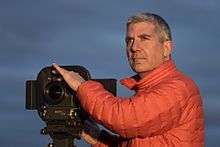Stephen Wilkes

Stephen Wilkes is an American photographer known foremost for his series of abandoned structures such as at Ellis Island and the former Bethlehem Steel factory both which he has captured as a lost world caught in a sort of visual amber. The Wilkes photographic essay on Ellis Island "Ellis Island Ghosts" helped to raise six million dollars from the United States Congress for the preservation of the structures on the south side of the island, including the former hospital for infectious diseases.[1] His fine art and photo-journalism have been featured in such publications as Vanity Fair, Sports Illustrated, and The New York Times Magazine.
The newest body of work by Wilkes is entitled, Day to Night. The work embodies epic cityscapes of Manhattan and other major U.S. cities with fleeting moments throughout the day to night. Wilkes photographs them from one camera angle continuously for approximately 15 to 18 hours. A select group of images are then electronically blended into one photograph. Wilkes has gone on to expand the series to international locations including Shanghai, Israel, and Dubai.[2] Wilkes first came up with the idea of shooting multiple images across a landscape when taking the cast picture for Baz Lurman’s blockbuster Romeo and Juliet for Life Magazine, in 1996. It wasn’t until he was asked to shoot the High Line for New York Magazine that Stephen used this technique to show the passing of time. He is fascinated by architecture, people, and the cities of the world, but what he really loves to shoot is history. He has even shot Day to Night images of President Obama’s inauguration speech as well as New Year’s Eve in Times Square.
On November 4, 2012, CBS Sunday Morning featured Wilkes in a segment on his process in creating Day to Night images.
External links
- Ellis Island Ghosts
- Stephen Wilkes Photography
- Article on an exhibition of Wilkes work at the Michener Art Museum
- Article on Day to Night work on NY Daily News
- Peter Fetterman Gallery
- Monroe Gallery
- Bernstein & Andriulli
References
- ↑ "Ghosts of Ellis Island". Pottsmerc. 19 September 2010.
- ↑ Durden, Tyler, "Day To Night" - 24 Hours Captured In A Single Frame: The Photo Gallery, Zero-hedge, 2013.12.25